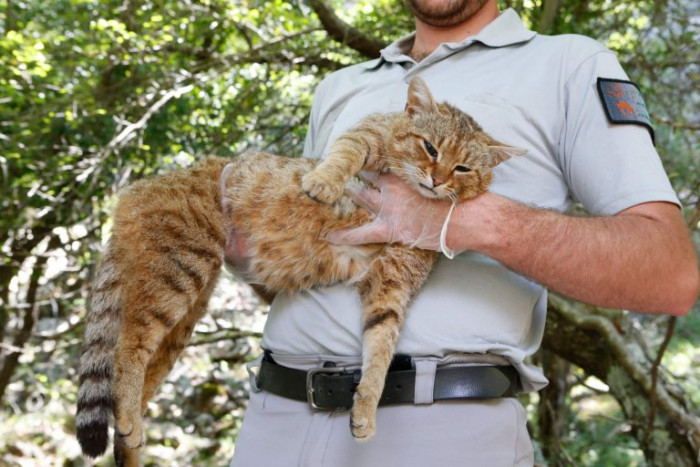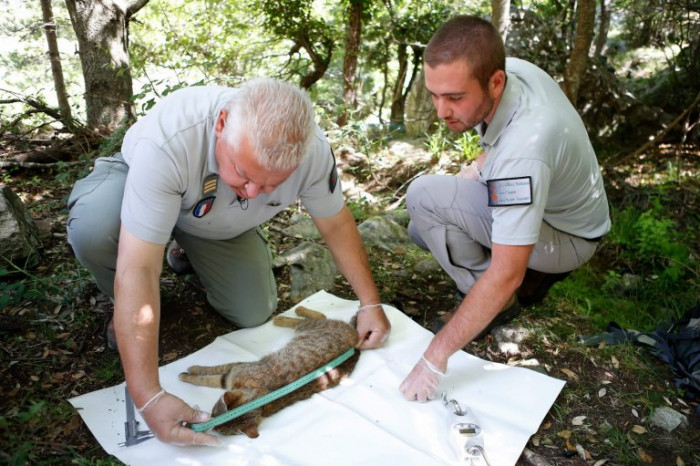
New Cat-Fox Species Has Been Officially Identified In France
Corsica, France is home to a newly identified species of wild cat

In the northern area of the Mediterranean Island of Corsica, France approximately 16 creatures roam elusively, looking similar to larger-than-average domesticated cats and recently they've gone from myth and legend to an officially recognized species of animal, rather adorably called "chat-renard," or cat-fox.
From head to tail, the critters that resemble our beloved domesticated cats measure 90cm (35in,) and it's features include "very wide ears," short whiskers, and "highly developed" canine teeth. Not only that, but their unique fur reminds local scientists of a fox, with a dense-silky coat, stripes on the front legs, very dark hind legs and a russet stomach. As well, the cat-fox's tail usually has rings, anywhere from 2 to 4, and a black tip.
Chief environmental technician of the National Hunting and Wildlife Office Pierre Bendetti said:
We believe that it’s a wild natural species which was known but not scientifically identified because it’s an extremely inconspicuous animal with nocturnal habits.
 AFP
AFP
Mr Benedetti’s colleague Charles-Antone Cecchini said:
The cat-fox is part of our shepherd mythology. From generation to generation, they told stories of how the forest cats would attack the udders of their ewes and goats.
 AFP
AFP
That gorgeous coat of fur is a natural repellent for fleas, ticks and lice.
 AFP
AFPThe cat-foxes have been spotted on the island as Ghjattu volpe and are found in the Asco forest and Cecchini said that they have a remote habitat where there is "water and plant cover offering protection against its main predator, the golden eagle."
 AFP
AFP
Benedetti has been studying the rare species for more than ten years and explains that it was only after years of playing "cat and mouse" with the species that one was surprisingly and unexpectedly caught, completely on accident, in a chicken coop, of all places, in Olcani of Cap Course.
 AFP
AFPIt took a few more years for research to officially get underway, but in 2012 they were able to determine the cat-fox's genetic make up by using a method that involved essence attractive to cats and a wooden stick that the critters would rub up against, leaving traces of their fur!
Mr Benedetti added:
By looking at its DNA, we could tell it apart from the European wildcat, Felis silvestris silvestris. It’s close to the African forest cat, Felis silvestris lybica, but its exact identity is still to be determined.
 AFP
AFP
It was yet another few years of trial and error before the combined efforts of advanced photographic and later physical traps, the researchers finally captured their first "cat-fox" in 2016.
 AFP
AFP
Today, many mysteries and unknown facts remain surrounding the cat-fox.
Benedetti's theorizes that the cat-fox may have been brought to Corsica by farmers in 6,500 BC, saying, "If the hypothesis is true, its origins are Middle Eastern." For now, other small mysteries remain, including the cat-fox's diet and reproductive patterns, both of which have yet to be studied at all.
 AFP
AFP
The cat that was humanely captured was no stranger to Benedetti, an identification chip in the creature's neck revealed a familiar male between 4-6 years old who had been caught a few times before. His eyes, one green and one brown, well one had been damaged in a fight with another male cat-fox. Benedetti and his colleague remove the GPS collar and replace it, so they can examine 80 days-worth of data and the cat-fox is safely released back to freedom.
Elana






